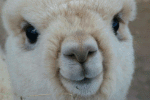Articles by Alpaca World Magazine:
Alpacas in Ireland
Xandria Williams
Xandria Williams, is most definitely a confirmed alpaca lover with a rosy view of the future of these animals. Here she reviews her first years in alpacas and the success of her company Alpacas of Ireland.
I first heard of and became interested in alpacas nearly five years ago and this seems an appropriate time to review where we are and how far we have come in central Ireland. By the end of that first year we were a quarter of the way through clearing and fencing the vastly overgrown files of very wet peat-land that was my recent inheritance. Over thirty alpacas had arrived, four, in varying colours, from a Chilean derived herd in France, who promptly gave me two adorable cria, and twenty six top quality Peruvian-derived animals, including our stud males, from a quarantine station in Canada. In the second year another forty five coloured Chilean animals arrived from the French farm. These were visitors, for us to sell on consignment. Since then we have added a second import of stud males to keep up the genetic variety, both for ourselves and all the females we have sold, plus additional geldings as the demand for them has outstripped supply. Fencing continued apace. Initially all this was done with a helper but eighteen months into the project the helper returned to the antipodes. After that “if it was to be it was up to me”. By the end of the third year the initial clearing was complete and all the fields were fenced. However I quickly learned the truth of ‘nature abhors a vacuum’. With the gentle climate and lush growth of central and eastern Ireland the fields simply refused to remain cleared. So clearing continues, but now with the help of the animals who have learnt to stand round for treats as I topple drunken leaning branches with the chain saw. Was I mad to firstly get into and secondly continue with the project? My accountant certainly thought so. Many friends thought so too. But I was convinced I was totally sane and had spotted not only a thoroughly enjoyable activity (my first focus, as I fell in love with the animals) but a niche occupation with a high chance of significant financial success – as it has turned out to be. The main income from farming alpacas comes from breeding and selling on the young. What will you do when no more animals are wanted, I was asked. I did some quick arithmetic and worked out that I, and probably the generation after me, would be a long time dead by then. There are very few alpacas in the world and they breed slowly. You will only get one cria at a time and,, for various reasons, you will get one most years but not every year and of course half of them will be (non-breeding) males. The numbers grow only slowly. It is thought that there are around 3 million. alpacas worldwide, as many as there are sheep in approximately one third of Ireland. Alpacas have only been exported from South America for the past twenty years and world wide interest in them is growing. The signs are there. America has been breeding them for twenty years and the price continues to rise as demand outstrips supply. The secondary, and ultimately the main income source from alpacas is the fleece. This fine, soft fibre somewhat between warm silk and cashmere in feel, has several advantages over wool. It is three times stronger, of very much less interest to moths and very much less prickly so that many people with wool allergies can wear it next to their skin. It is used in the luxury fashion industry for stunning garments (Queen Victoria had a gossamer ball-gown made of it) as well as practical ones, is long-lasting (Victorian gentlemen had their alpaca overcoats that they passed on to their sons). Demand for alpaca products grew in the nineteenth century when raw fleece could be imported from South America. Commercial mills are able to spin large quantities of alpaca fleece. Clearly we have a long way to go yet before there is the remotest possibility of saturating the market with alpacas. With imports and many births causing our numbers to rise and dozens of sales reducing them the total number of animals at Killinagh has ranged from around 70 or 80 to 130. We have sold animals into 18 different counties (as well as overseas) and to many more owners. I hate sending the females off to new homes, but there is always the consolation that they will return for breeding with our stud males and it is a delight to have them back each year, even if it is only for a few weeks. We sell the fleece to several different home ‘spinners’. The rest of the fleece is spun into yarn and then sold through various craft outlets. Even now, with the economies of small scale working against us, the income from this more than covers the cost of shearing and many other aspects of the animal care. As the industry grows, of course, this income stream will improve, both in absolute terms and in relation to the cost of the animals. Have there been problems? Certainly. There are always problems in any industry or business, and this is especially true when dealing with animals. Have animals died? Yes, not many, but some and mainly in the group that made up the initial imports. These start-up animals, having been flown round the world in several stages and subjected to many different quarantines and methods of transport, were understandably stressed. But since then we have lost relatively few. As any farmer or pet owner will know, some animals do get sick, some do die – the same is true of humans. But by and large they have thrived and done well on our land. Are alpacas suited to Ireland? Yes, I think they are, certainly in central Ireland where we are and in the east and south. It is relatively dry, the temperature rarely goes about 26C which is about the upper limit of what they are used to in South America, and the rare fall of snow bothers them not at all. It may be that in the wettest parts of western Ireland the constant or heavy rainfall is too much for them but that is a relatively isolated problem. They have a lot to offer Ireland, not least of which is the fact that they can be run on the wet and soft soils or peat where no other animals could be farmed. Many farms have patches of this land that lie unused. In their native habitat alpacas choose the marshy ground and enjoy a diet with generous amounts of marsh plants including rushes. We did have some Suris at the start but in the end changed them for Huacayas. The Suris look wonderful in dry climates. On my land, where there is peat, moss and a variety of brambles and other organic matter that can get caught up in the fleece they never looked their best; and because their fleece tends to part along the spine, the skin there became affected by the rain. In other parts of Ireland they may do better. Has it been financially successful? Indeed it has. It is very clear that this is a financially viable method of independent farming,. Total sales have been greater than all our start up and running costs, sales have been steady and are on the increase and even so our own herd has grown. Even my accountant is now a converted enthusiast. Has it been hard work? Ironically no. Clearing the land was the biggest job. Once that was done things settled down to a steady routine. From the start I have had the help and support of Nick Harrington-Smith and that continues to this day. I have some wonderful alpacaholic friends and co-workers who help out and watch over there herd in my absence as well as when I’m on the farm. Most of the work is covered by an hour or so a day feeding and checking the animals and a full days work at the week-end. Most of this latter involves mating and caring for the cria in their early stages and falls to us as we do our own breeding and also take care of the breeding of other people’s animals. Without that there would be relatively little to do even in the summer. In the winter, when the mating and the cria births are part of summer’s memory, there is much less to do. The temptation to linger over any job and simply watch and enjoy the animals is always there and often succumbed to. Is their breeding simple? Generally yes. They don’t always get pregnant at first mating but usually do when re-mated. Some are more difficult but they are the exception, if it happens to be a client’s animal, we replace her – if the client can bear to part with her! They occasionally have difficult births but after dozens of births over four summers we have had none, other than one still birth. An occasional premature birth has lead to a need for increased care of the cria or possibly a loss. As the first people selling animals throughout the country we are keen for the industry to get off to a good start. We have run a variety of courses – husbandry, animal selection, breeding, spinning etc. We encourage clients to insure their animals. We sell our females either pregnant or with a free breeding until a live birth is achieved; if it is not, we replace the female. If a client has second thoughts soon after purchase we have exchanged their animals and if, later, they wish to sell we are happy to help them with this too. We agist animals for clients until they are ready to receive them and we offer ‘slow motion’ purchases whereby an animal can be paid for by instalments over time but the purchaser manages the animal from the start, chooses the breeding and keeps the resulting cria. This has helped people to get started when they cannot afford to buy the initial minimum of two animals outright. Has it been worth it? The answer is a resounding yes. These are gentle, curious, engaging animals that are easily fenced, need little or no housing, are generally obedient as to where you want them to go, particularly once you begin to understand their psychology, and they provide hours of pleasure. Working with the alpacas has been and continues to be a delight and spending the week-ends outdoors is exhilarating and uplifting, whatever the weather. There is the pleasure of working with the animals themselves, the joy of the birth of each cria, the peace of walking slowly behind a group of them as they are guided back to their field, the interest of watching the inter-relationships they develop within the larger herd, the fun of the shows and sharing the interest with the people that come, and of course there are our clients and the relationships that form with them. Any moment when I have little to do I simply stand and stare, taking in the visual delight of field of one or two dozen of these graceful animals. When I have even less to do I take a book into a field and read it there and am honoured when an animal is sufficiently trusting to come close and investigate. Am I mad. No, gloriously sane !!
Tweet


